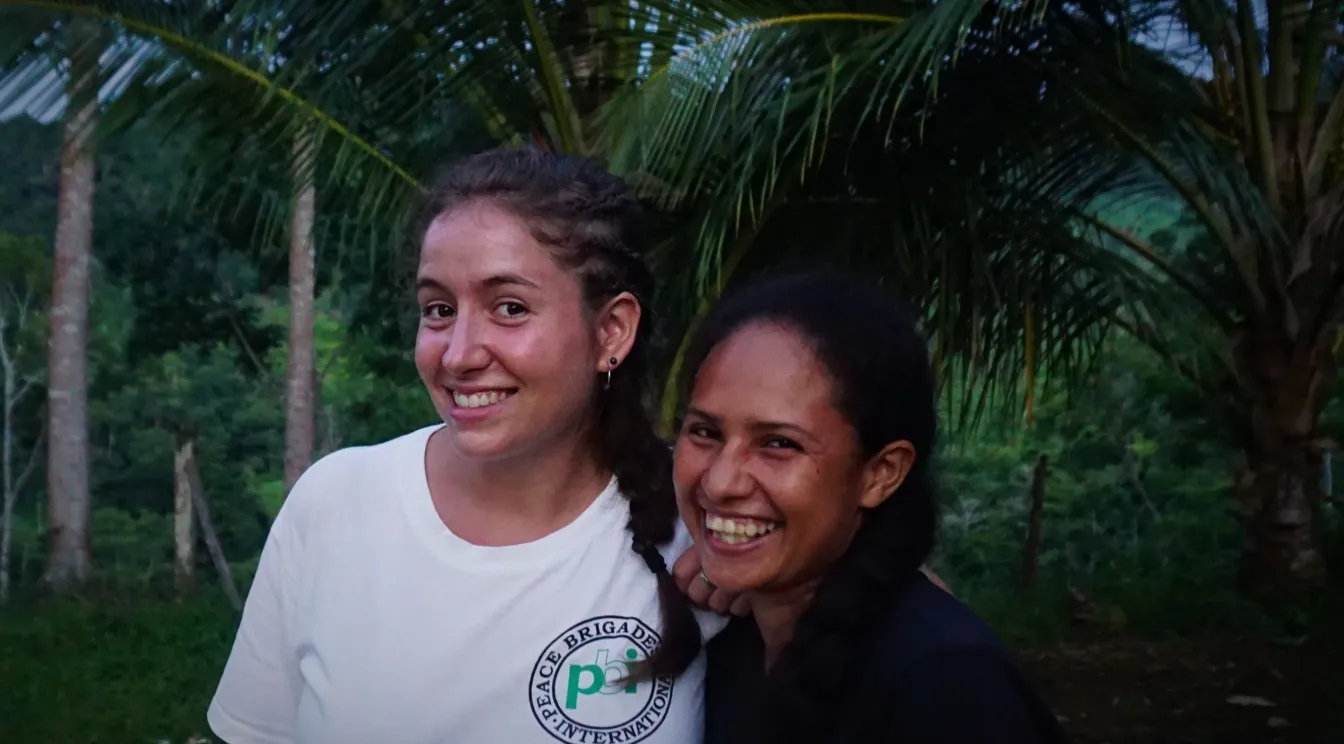Article by PBI-Colombia
The Peace Community of San José de Apartadó, located in the region of Urabá Antioqueño, was formed in 1997 amid the violence generated by the armed conflict. Peasant farmers from different villages signed a declaration that identified them as a Peace Community which rejected the different armed groups present in their territory by proclaiming their active neutrality[1] and through the concept of distinction of IHL. After almost 25 years of peaceful resistance, it continues to be an inspiring model of community life that has also promoted the incorporation of perspectives on gender equality allowing for an evolution in the political and social participation of women. It is this perspective that we analyze together with Sirly Cerpa, who was a member of the Peace Community´s Internal Council for six years.

Originally from the Alto Joaquín village in Tierralta, in the department of Córdoba, Sirly and her family were displaced when she was still very young. It was upon returning to their land that they met the Peace Community of San José Apartadó, and as she tells us, joining the Community represented something as simple and vital as the possibility of returning to work the land in the fields. “It was about building protection for each other. It was a beautiful way of life.” After three years of being part of the Peace Community, she was asked to be a member of the Internal Council, and although at first she didn’t feel ready, the fact that the community saw that she had the right skills made her accept this part of the responsibility that came along with being part of a collective process of this nature.

Reflecting on the organizational framework from a historical perspective, women have always been an integral presence within the San José de Apartadó Peace Community. In the 1990s, confrontations between guerrillas, paramilitaries and the Colombian Armed Forces engulfed the region while massacres[2] and forced displacements[3] followed one after another. The Community had the need to establish routes of action in case of dangerous situations, always contemplating the possibility that their leaders would be killed. If that happened, it would be the women who were left in charge of the homes and the Community as a whole, along with the responsibility of leading and protecting it. That´s why they themselves decided that the Internal Council was a space they also had to take ownership of.
They began with a minority representation within the Council, but today the voices of men, women and young people strive to be recognized, represented and heard equally within these organizational spaces. “Some of the first to serve were older women, others were young and many of them were mothers, but despite their fear, [assuming leadership] was a risk that had to be taken. It wasn’t that they were all extremely brave or wanted to be the center of attention, but they had to defend the Community and contribute as much as they could. If a comrade was killed, someone else had to be able to take his or her place.”

Caption: “Sometimes one might be led to believe that women are weaker, or that they have fewer capabilities, but we face each day head on with the confidence and certainty that, if at some point our partners are absent, we women will fulfil our role at the head of the Community”.
The change in the political situation has meant that nowadays there is more scope for women to decide whether to participate in the processes relating to the work of the Internal Council[4], depending on their personal circumstances. In her case, after six years of service and having recently decided to start a family, Sirly felt that it was time to give up the space within the Council to other people.

Her time in the Council made her realize that “everyone – man or woman – can contribute something essential and, because they always have the support of the rest of their colleagues, they will be up to the task”. She also stresses the importance of women being active internal decision-making and work, not only because “it helps to validate the figure of women”, but also because they need and want to see their voices represented.
In terms of the existence of specific spaces for women’s meetings, Sirly says that they try to generate them informally on a daily basis, especially on community workdays when they share certain tasks such as cooking or cleaning sugar cane. For a long time, however, the Community has been trying to ensure that there are no specific tasks for men and women, and many of these previously segregated spaces have now become mixed. Despite this, they make sure to always find other spaces to share among women. In many respects, the participation of women on equal terms within the leadership of the peasant farming movement has been a turning point within the Peace Community. By highlighting how their collective history is marked by each of their experiences, it has given meaning to all the cumulative political experience they have developed, reaffirming and deepening their political, social and cultural journey and actions based on their identity and lived realities. The leadership of women is the physical expression of the emergence of a new organizational culture that really tries to include women.

Photo: Charlotte Kesl
For Sirly, her commitment to the Community did not end when she left the Council, she continues to play a fundamental role within it. Her colleagues trust her as a person of many abilities, skilled and knowledgeable about the internal work and processes of the Community. For this same reason, some time ago they suggested she support the Community’s educational activities by giving classes to the children of the settlements closest to the Aldea Rigoberto Guzmán, where she currently lives. As she explains, the situation has changed, but the context of violence is still present in the territory.

After the Peace Agreement, the paramilitary presence increased and occupied the territories that the guerrillas had liberated. Since then, and despite the presence of the army, the paramilitaries have remained strategically close to the peasant settlements, generating a complex territorial and social control. Leaders are constantly being threatened and harassed, something they attribute to the governmental and business strategy within the region of Urabá. Community members are aware of the complexity of the context and the dangers they continue to face such as increasing forced recruitment of minors by paramilitarism. For this reason, and due to her tireless commitment to the Community´s collective work, Sirly accepted the proposal to work as an educator. She believes in giving the youngest members an education that will encourage them to internalize the Peace Community´s history and memory and which will also mean that someday they´ll also want to give back what they have learned to the collective. It´s a two-way process which provides continued support: from them to the community, and from the community to the people who make it up.

Photo: Charlotte Kesl
Sirly is somewhat pessimistic about the reality of the region but is clear that the Peace Community has the capacity to continue building the future they want “because we have suffered, but we have continued to fight for the territory and for our memory”. She believes that the support of international accompaniment has in many ways allowed the Community to maintain itself and continue working. “Let them know and let them see that we are not alone. We are here. We have resisted for almost 25 years and we will continue to do so.”

Today, these women continue to march alongside their male peers in a process that has called them to look back on their history and the road they have traveled in defense of the land and territory in order to articulate their experiences as women within the wider peasant movement. Through their participation they have developed and made known their become active in politics and the exercise of their rights.
Urabá Team – PBI Colombia
[1] They are neutral but carry out political actions in favor of peace.
[2] Massacres involving Peace Community members took place in September 1996, February 1997, April 1999, February 2000 and February 2005.
[3] Forced displacements of Peace Community settlements in various settlements took place in March 1997, September 1997, September 2001, and between June and October 2001 in the settlement of La Unión. There were also 7 instances of forced displacement of families in the settlements of Mulatos and La Resbalosa between 2003 and 2004.
[4] Body which provides legal, judicial, administrative, and organizational representation.


